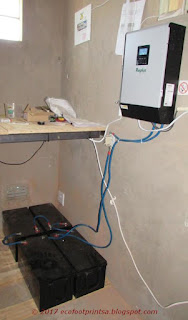 |
| RSon convinced RMan to reconfigure the solar panels - to allow for additional panels to be added in future - IF they were required. |
In June 2014 we removed, re-wired / adjusted and re-installed / re-configured our 8 X 145 watt solar panels in parallel (amps) instead of the original series (volts) and the voltage spiking we had been experiencing during the coldest time of the morning (sunrise) was solved. The 80 Amp Outback charge controller remained, but we also upgraded our Cotek inverter from 1000 watts to 2000 watts.
The system has served us well and has kept the house running for just under 5 years.
But, our initial mistake in 2012, was to install a 12 volt system. Our (uneducated and, in hindsight, illogical) reasoning at the time was that camping stuff is mainly 12 volt (to run off car batteries) and therefore those off grid appliances available to us would be in 12 volt. Plus - honestly - it was what we could afford at the time.
However, appliances that are now being manufactured are far more solar power friendly - using less watts to perform the same duty, if not more, as the limited older make appliances.
But our major power guzzler is our fridge.
We purchased an A+ fridge / freezer combo in December 2014 which only uses 132 watts / day (or 484 kWh / year). But - a fridge works 24 hours a day - during the daylight hours it draws it's power from the batteries which are concurrently being charged by the panels, and it continues draining the batteries during the night - when no charge is happening. In itself, that would work brilliantly, but add to that all the other household gadgets (TV, decoder, wi-fi, phones, laptop and printer [9 hours a day for our business], once a week vacuum cleaner (the broom suffices on the other days), lights, bread maker every other day, etc and our batteries were taking a bit of strain.
One of our 6 X 2 volt lead acid batteries failed over December - when the solar suppliers were shutdown for the Christmas season. Isn't that always the case!?! One of our neighbours, who had just experienced a break-in, and theft of his 3 X 240 watt panels, charge controller, inverter and 1 of his 5 X lead crystal batteries, kindly lent us his remaining 4 batteries which the thieves had found were too heavy to make a quick getaway with. That act of kindness also ensured that his remaining batteries were not left in situ / vulnerable for the thieves to return and collect the balance of his system.
RMan was very impressed with the performance of the lead crystal batteries. They have the ability of being able to be "drained" pretty low without retaining a memory of that drain - as is the case with the majority of other solar batteries.
So, RMan decided that an upgrade of our system would be in order.
We ordered another 2 volt lead acid battery to enable us to continue with our original 6 X 2 volt (12 volt) system.
In addition, we ordered 3 X 300 watt solar panels, 4 X 12 volt 200 Ah lead crystal batteries and a 5 kva 48 volt Replus charge controller and pure sine inverter combined. The beauty of the Replus is that it is one unit, instead of two, and, providing enough power is being produced by the new panels, it enables power to be drawn straight from the panels whilst the panels are simultaneously charging the batteries.
The new 4 X 200Ah 12 volt lead crystal batteries are wired in series to provide 48 volts and do not produce any fumes - unlike the old 6 X 2 volt lead acid batteries.
 |
| With the roof space that the reconfiguration provided, there was more than enough space to add 3 X 300 watt panels |
Naturally, RSon to the rescue once again - climbing round the roof to install the new panels... even though the 300 watt panels were much heavier than the 145 watt ones, at least he had the lower roof to stand on, which made getting them up on the roof and installing them much easier.
We have the two systems wired separately. And - after RMan did a fiddle here and there, and installed a new power source to the house - they supply power to two different parts of the house.
 |
| The old system : 6 X 2 volt lead acid batteries Outback charge controller and 2000 watt Cotek inverter |
The old system powers the bedrooms / lounge / garage (minimal drain from there - just power tools every now and then).
The new system powers only the kitchen i.e. fridge plus 2 plugs (1 for my "Audi lights" and the other for my blender stick / mixer and bread making machine).
With 3 X 300 watt panels, wired in parallel, feeding 4 X 200Ah lead crystal batteries, power generation / provision to the kitchen is brilliant and, most importantly, less demanding on the system.
 |
| 4 X 200 Ah lead crystal batteries and the Replus charge controller and inverter combined. |
S'funny - you would think that a couple of low wattage lights, a TV, decoder and wi-fi (+/- 40, 35 and 30 watts respectively or +/- 120 watts together) would be easy for a system to handle. But, over the course of an evening (4 - 5 or more hours) that equates to 600 + watts. Add that to the fridge which runs for 12 minutes every 8 (on for 12 minutes off for 8 minutes ) and power consumption at night was generally working out to be higher than the entire house during the daylight hours. We were consuming +/- 2 - 2.5kWh at night - when no power was coming into the batteries and the 6 X 2 volt batteries (when it was overcast for extended periods) were sometimes battling to handle it on their own.
Now that the load is shared - I am even able to use my 1200 watt hair dryer for 8 - 10 minutes (once a week) - providing that I use it during daylight hours - and have allowed the batteries to have a bit of charge before I place such a high demand on them. So, until about 9.30 - 10.00 a.m. my hair drips dry. Thereafter I am able to give it some semblance of a style.
Definitely no more power worries in this house anymore.
Cost?
For a stronger, more powerful system it was approx. 50 -55% of the total cost of our original solar set-up.
Sometimes I get giddy at the amount of power I now have at my fingertips... :D
Our old system, which is 5 years old, has paid for itself. 5 years of powering our home / business "head office" - if we has used grid power we would have paid more than the original system cost us - for the rural levy only (+/- R680.00 / month)!!! The cost of the KWh we used would've been added to that. Our old system is still going. And now it's life is extended because it has "help" :D
We will not have to switch off our lights for Earth Hour tonight because we, personally, don't need to protest against our power being supplied by coal fired nor nuclear powered power stations - notwithstanding the power required to produce the various components - for only the sun is providing the power for us to use.
However, for the sake of this planet - long term - and for the sake of romance, we will be using only candle light tonight... :D
Disclaimer: Products mentioned on this blog posting are products we have purchased for our purpose. That does not imply they will be sufficient for your requirements / purpose. No supplier is aware, nor has paid us, for mentioning their products.
For info on how you can obtain your own Foothills DryAway solar / wind food dehydrator please click the link.




















